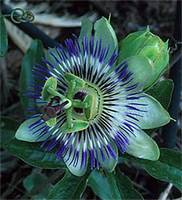
The Passion Fruit: The spiraled tendons of the plant, he notes, were taken as symbols of the lashes Christ endured, and the central flower column as the pillar of the scourging. The 72 radial filaments of the flower were seen as the crown of thorns; the three stigmas as symbols of the nails used in the crucifixion, as well as the holy Trinity; the five anthers, as the five wounds of Christ; and the style as the sponge doused in vinegar used to moisten Christ's lips. Taken together, the five petals and five sepals were used to refer to the ten apostles who did not either betray or deny Christ. The fragrance of the flower, continued Pons-Worley, helped recall the spices used to embalm the body of Christ. Finally, its globular egg-size fruit was taken as a symbol of the world that Christ saved through his suffering.
Palm Sunday
Jesus came to Jerusalem,
the week he was to die,
riding on a donkey,
riding strong and high.
Children ran to meet him,
palms in hand they sing:
"Hosanna, Son of David,
"Hosanna to our king."
Monday
The week he came another man died,
Lazarus was his name.
"Come out of your grave,"
Jesus cried,
and out of his grave he came.
Thank you, God of Life;
you want me to live, not die.
Tuesday
That week there was another man,
a man who could not see.
Jesus rubbed his eyes and said,
"Believe and you will see."
And believing,
the man could see.
Thank you, God of Light,
for giving light to me.
Jesus taught in the temple that week,
the week he was to die.
You'd think he'd be liked
for all that he did.
But some said, "No!"
"He's trouble!" they cried.
So they wanted him to die.
Wednesday
On Wednesday, one of his friends
(Judas was his name)
went to the leaders and said:
"I know where he goes,
"I know where he stays.
"He's yours, if you want him."
"We want him,"
they said.
Holy Thursday
On Thursday night,
("Holy Thursday ")
Jesus ate with his friends.
Now, you should know
that same night,
long ago,
God freed his people
from the chains of Pharaoh.
Bread and wine
Jesus gave to them:
"Here is my body,
"And here is my blood.
"It will make you free.
"When you do this," he said,
"remember me."
They went to a garden,
after the meal,
and Jesus knelt and prayed:
"Father, my Father,
"help me.
"Help me, I'm afraid."
Then Judas came,
and soldiers too,
who put him in chains,
and took him alone
to Pontius Pilate
who sat on a throne.
"He dangerous!"
"He must die!" they cried.
And Pilate, for no reason, replied:
"He must be crucified!"
Then they whipped him,
and pushed him
to a place called Calvary.
He fell sometimes,
carrying the cross,
cut from a heavy tree.
Good Friday
On Friday,
(We call it "Good")
Jesus was nailed
to hard, hard wood.
Beneath his cross,
his mother stood
and cried for what they had done.
"Oh, if I could hold him," she said,
"Hold my only Son!"
"Father, take me," Jesus said,
"Take me in your hands."
And God reached down
and took him,
and held his only Son.
"I am God who raises up,
"your life has just begun.
"I am God of the living,
"no grave can hold my Son."
Easter
Jesus came to Jerusalem,
the week he was to die,
riding on a donkey,
riding strong and high.
On Sunday,
when the week was done,
Jesus rose from the dead.
"Praise God! Alleluia!"
Risen is God's only Son.
Thank you, God of Light,
for giving us light to see.
Thank you, God of Life,
for giving Jesus to me.

